#polyester woven fabric
Explore tagged Tumblr posts
Text
What's Polyester Woven Fabric?
What's Polyester Woven Fabric?
Polyester can be an artificial fiber, and a typical fabric for clothing. There are excellent durability, insulation, in addition to wrinkle resistance. This causes it to become great for outdoor put on, jackets, and even garments. It's also a extremely inexpensive option for linen production.
Woven fabrics are made by interlacing yarns together in a very woven pattern. They in many cases are used to make covers, tarps, and pillows. They're durable and can fight water, mold, and mold.
They're available in many colors and can be printed with images, styles, and other graphics. They're also commonly used for a great deal of applications, including wall decor and upholstery.
This type of polyester woven fabric is perfect for garments and other products that are designed to be worn for long time frames, as they are easy to clean and maintain. They are also an ideal choice for children's clothes in addition to toys, as they are soft and easy to look after.
These types of woven polyester fabric can be available in various weight load, deniers, and thread counts. These options help you to search for the perfect polyester fabric to your project.
190D and 210D are the most used polyester denier options. The more expensive the number, the thicker plus much more durable the fabric are going to be.
1000D is a heavier fabric which is suitable for backpacks, gear, and outdoor gear. It can be used for hats plus uniforms.
1600D is an insulating fabric which you can use for winter apparel. It may also be used for pillow completing and tuffed blankets.
Our 65% Polyester / 35% Cotton Twill is definitely excellent polyester twill fabric for a range of garments and uniforms. It is additionally a popular choice with regard to uniforms in correctional facilities.
We offer a wide selection of polyester woven fabric options which might be custom printed with your logo along with graphics. You can upload your individual design or use considered one of our pre-made templates.
These polyester woven fabric options can be purchased in several thicknesses, needle matters, and weave widths. They are often manufactured with a selection of threads, fibers, and remedies, and are ideal with regard to filtration, absorbent, insulation in addition to specialty applications.
The most common polyester woven fabric can be a polypropylene-based material which they can use to create a combination of products. These fabrics are durable which enable it to be machine-washed and dehydrated.
Some of these sheets are woven into several designs and patterns, making them a versatile option for a handful of applications. These woven polyester fabrics can be used for bedding, draperies, and tablecloths.
They can be woven with a bunch of dyes, and can be printed with lots of designs and patterns. They can even be used for a a number of purposes, including sizing in addition to seaming.
They are generally not as soft as natural materials like silk or wool, but they can often be textured and manipulated to create a number of effects. They can likewise be mixed with additional fabrics, which can customers a more comfortable look.
1 note
·
View note
Text
Exploring the Advancements in Textile Manufacturing: How Companies are Innovating the Industry
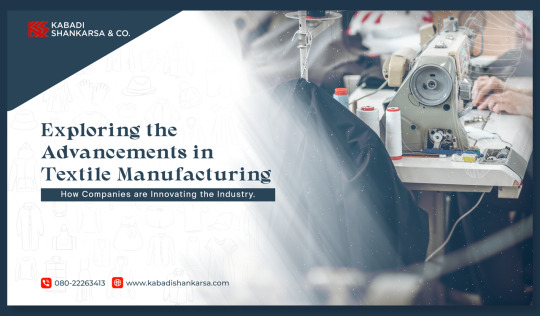
The textile industry is constantly evolving and advancing, and textile manufacturing companies are at the forefront of these changes. One area in which we are seeing significant innovation is in the production of woven fabrics. Woven fabrics, which are made by interlacing two sets of yarns or threads at right angles to each other, are used in a wide variety of products, including clothing, home furnishings, and industrial products.
One of the most exciting developments in the world of woven fabrics is the use of new and advanced weaving technologies. These technologies allow manufacturers to create fabrics with unprecedented levels of precision and control, resulting in fabrics that are stronger, more durable, and more consistent in quality.
One example of these new technologies is the use of computer-controlled looms. These looms, which are operated by computers, can be programmed to create a wide variety of patterns and designs, allowing manufacturers to produce fabrics that are truly unique and customized to their customers' needs. This technology also enables textile manufacturing companies to produce fabrics at a much faster rate, increasing productivity and efficiency.
Another area in which textile manufacturing companies are innovating is in the use of sustainable and eco-friendly materials. Many companies are now using natural fibers like cotton and linen, as well as synthetic fibers made from recycled materials, in their woven fabrics. This not only helps to reduce waste and conserve resources, but it also allows manufacturers to create fabrics that are kinder to the environment.
Finally, textile manufacturing companies are also exploring new ways to use technology to improve the overall supply chain of textile manufacturing. The use of automation in textile manufacturing process has enabled companies to increase efficiency, improve quality control and reduce costs.
In conclusion, the textile industry is constantly evolving and textile manufacturing companies are at the forefront of these changes. From new weaving technologies to sustainable materials, textile manufacturers are finding new and exciting ways to innovate and improve the products they produce. This is an exciting time for the textile industry, and we can expect to see even more advancements in the future.
Kabadi Shankarsa is one of the leading textile manufacturers in India. Upgrade your textile production with our state-of-the-art manufacturing equipment. Our machines are designed to increase efficiency and reduce waste, resulting in cost savings for your business.
Don't miss out on this opportunity to take your textile manufacturing to the next level. Contact us today to schedule a consultation and see how we can improve your bottom line.
#fabric manufacturers#textile manufacturing companies#embroidered fashion fabrics#textile manufacturers#silk scarves for women#non woven fabric manufacturer#woven cotton fabric#sustainable fabric suppliers#woven geotextile fabric#automotive fabric suppliers#polyester woven fabric#organic fabric suppliers
1 note
·
View note
Text
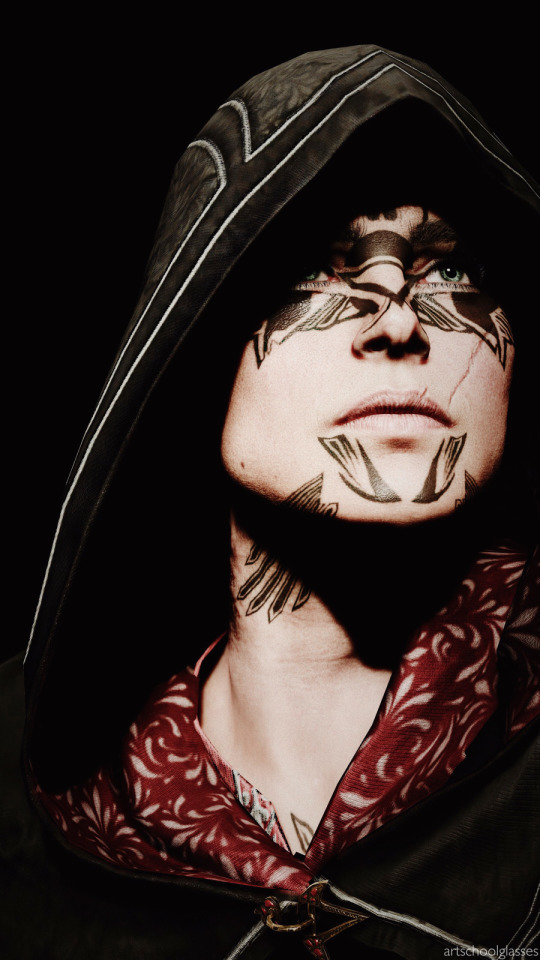
Taking pictures for a monthly challenge going on over on the bird hellsite. Hence the armour set I don't usually wear...
Assassin's Creed Valhalla
#assassin's creed#assassin's creed valhalla#ac valhalla#valhalla#eivor#eivor varinsdóttir#eivor wolfkissed#eivor wolf kissed#virtual photography#photomode#video game#playstation#ps5#*whispers* I don't usually wear this armour because I think Ubisoft somehow managed to make the fabric look like cheap printed polyester 😬#don't know HOW they managed that#it doesn't look like a natural woven patterned fabric at all#and I can't get past it 🙃
42 notes
·
View notes
Text
Exploring the Elegance of Printed Velvet and Cotton Velvet Fabrics at Sanchi Velvets
Velvet is a fabric synonymous with luxury, and over the years, its versatility and beauty have only increased with the advent of modern fabric innovations. Among these innovations are printed velvet fabrics and cotton velvet fabrics, two styles that combine velvet’s plush texture with contemporary designs and natural materials. At Sanchi Velvets, we offer an exceptional range of both printed and cotton velvet fabrics, each bringing its own unique appeal to the world of fashion, upholstery, and home decor.
Printed Velvet Fabric: The Perfect Fusion of Texture and Design
Printed velvet fabric is a stunning evolution of traditional velvet, offering the perfect combination of luxurious texture and vibrant, detailed designs. Digital and screen printing techniques allow for an endless array of patterns, from rich florals and abstract designs to geometric patterns and even photorealistic imagery. The velvet surface, with its soft pile and deep colors, provides the ideal backdrop for these intricate prints.
Key Features of Printed Velvet Fabric
Vibrant Designs: The printing process results in sharp, bright patterns that truly pop against the plush velvet fabric. Whether you're looking for a traditional floral print or a bold modern pattern, printed velvet offers an unmatched depth of color and visual interest.
Luxurious Feel: Despite the intricate designs, printed velvet retains the signature luxurious feel of velvet, with its soft, rich texture that is perfect for both fashion and home decor.
Versatile Applications: Printed velvet is a perfect choice for creating high-end fashion pieces such as dresses, skirts, blouses, and accessories. It’s equally well-suited for interior design, from statement upholstery and cushions to curtains and bedspreads.
Customizability: At Sanchi Velvets, we offer printed velvet in a range of patterns and colors, allowing for full customization for designers and consumers seeking to make a bold style statement.
With printed velvet, you have the opportunity to create sophisticated garments and furnishings that stand out. The luxurious texture combined with unique designs makes it a go-to fabric for anyone looking to create pieces that are both tactile and visually striking.
Cotton Velvet Fabric: Soft, Breathable Luxury
Cotton velvet is an incredibly popular choice for those seeking the luxury of velvet without the weight and warmth of traditional velvet fabrics. Made from cotton fibers instead of silk or synthetic materials, cotton velvet offers a soft, breathable alternative while still maintaining the rich texture and depth of traditional velvet.
Key Features of Cotton Velvet Fabric
Natural Breathability: One of the main benefits of cotton velvet is its breathability. Unlike synthetic velvet, cotton velvet allows for more airflow, making it a more comfortable option for warmer climates or for designs that require long wear.
Soft, Smooth Texture: Cotton velvet maintains the soft, tactile feel of traditional velvet but is often lighter and less dense, which makes it easier to work with for clothing and upholstery projects.
Eco-friendly Option: As cotton is a natural, renewable resource, cotton velvet can be considered an eco-friendlier option compared to synthetic velvets, offering a more sustainable choice for conscientious designers and consumers.
Versatility in Fashion and Decor: Cotton velvet is highly versatile and can be used for both casual and formal clothing. It is a favorite for fashion pieces like dresses, skirts, and jackets, as well as home decor items such as cushions, bed covers, and upholstery.
At Sanchi Velvets, we offer cotton velvet fabrics in a variety of colors and finishes, perfect for creating both elegant garments and cozy, stylish interiors. Whether you're looking to design a flowy cotton velvet dress or transform your living room with cotton velvet cushions, our fabrics bring soft luxury to any project.
Choosing the Right Velvet for Your Project
When deciding between printed velvet fabric and cotton velvet fabrics, consider the intended use and the specific qualities you're looking for in a fabric.
Printed Velvet Fabric is perfect if you're seeking a fabric with intricate patterns, bold designs, or photorealistic prints. Whether you're designing fashion-forward apparel or want to create a statement piece in your home, printed velvet brings visual impact and luxurious texture to your project.
Cotton Velvet Fabric is ideal for those who want a softer, more breathable fabric that still offers the richness and depth of velvet. It’s a great choice for lightweight clothing, casual wear, or home decor pieces that demand comfort, elegance, and sustainability.
Conclusion: Discover Velvet’s Versatility at Sanchi Velvets
At Sanchi Velvets, we pride ourselves on offering a wide range of premium velvet fabrics, including both printed velvet and cotton velvet. Whether you're designing a high-fashion garment, crafting elegant home decor, or creating a unique, custom piece, our velvets provide the ideal combination of luxury, texture, and design flexibility.
Printed velvet offers the excitement of bold, detailed patterns, while cotton velvet provides soft, breathable comfort for a more laid-back elegance. No matter your project, Sanchi Velvets ensures that you'll find the perfect fabric to bring your creative vision to life.
Explore the luxurious world of printed and cotton velvet fabrics at Sanchi Velvets today and discover how these modern takes on a classic fabric can elevate your next design.
To know more about Sanchi Velvets visit us:
#Sunshine Velvets#Gold Line Velvet#Dispro Print Velvet Fabric#Disperse Print Velvet Fabric#Non Velvet Burnout Fabric#Cotton Slub Velvet#Velvet Manufacturers India#Cotton Viscose Velvet#Ice Velvet fabric#Viscose Rayon Velvet#Woven Velvet Fabric#Light Weight Velvet Fabric#Heavy Weight Velvet Fabric#Polyester Viscose Fabric#Foil Print Velvet Fabric#Digital Print Velvet Fabric#Polyester Velvet Fabric#Printed Velvet Fabric#Cotton Velvet Fabric#Polyester Satin Fabric#Floral Printed Velvet Fabric
0 notes
Text
For the past 3 months I've been very restrained and have only gone to the thrift store once a month (both because I don't want my stash to get out of control, and also I have very few moneys) but aggghh it's going to be so hard to not go back in a week or two, because guess what I found this time?

NINE AND A HALF METRES OF GLAZED 100% COTTON. For 8 dollars! I don't think I've ever found a cut that big of anything there! (Though I did once get 6 metres dark blue of wool suiting for 4 bucks from a different thrift store.)
I also found 2 pieces of the same kind of cotton voile I used for the red shirt, one black and one purple, and there's enough of each to do an equally big shirt.
I keep telling myself "ok, storage space is limited, you can't keep bringing home this much fabric every time you go to the thrift store" but then I keep finding amazing fabrics that I can't leave there.
#thrifting#fabric#sewing#also just under 2m of a beautiful cream/white/brown woven stripe shirting#and some slippery black polyester lining that I'm going to use for another underpetticoat for my mannequin.#oh right I still need to photograph and post the one I made for him last week#still have not overdyed that damask but I did some samples a while ago and need to do more to get the colour right
439 notes
·
View notes
Text
Tarpaulin PVC Coated Woven Polyester Fabric For Tent or Truck
Zhejiang Huasheng Technology Co., Ltd. (stock abbreviation "Huasheng Technology", stock code "605180") was founded in 1996. It is located in Haining warp knitting industrial zone, Haining city, Zhejiang, China.As famous China Tarpaulin PVC Coated Woven Polyester Fabric For Tent or Truck Suppliers and ODM Tarpaulin PVC Coated Woven Polyester Fabric For Tent or Truck Company, The company belongs to the industrial textile industry in the textile industry. It is a high-quality supplier in the field of plastic composites and a member of China Nonwovens &Industrial Textiles Association. The company is deeply engaged in the production and R & D of custom Tarpaulin PVC Coated Woven Polyester Fabric For Tent or Truck and has established a provincial research and development center for high-tech enterprises.It has strong independent innovation ability and technical advantages, has a number of core technology intellectual property rights, and participates in the formulation of national, industry, alliance standards etc.
Cargo materials are applied for truck tarpaulins, side curtains, container curtains, building and storage covers etc upto 3.20m wide. With good weldablity and easy clean lacquering coating (upon request) the material is durable. Such tarpaulins are available in many different colours and could be customer-made.
Phone:+86-0573-87987519 Email:[email protected] Address:NO.8 HONGQI ROAD,MAQIAO STREET,HAINING,JIAXING, ZHEJIANG PROVINCE,CHINA,314419

0 notes
Link
Woven Fabric Manufacturers - Response Fabrics
Woven Fabric Manufacturers
If you want to get the best Woven Fabric Manufacturer in India then Response Fabrics is one of the top well renowned manufacturers of a broad assortment of Woven Fabric, Upholstery Fabric, Mesh Fabric, Blackout Fabric, etc. The offered fabrics are woven at the well-developed manufacturing unit by making use of premium quality yarns, and threads in compliance with defined quality standards. The production department is well-furnished with ultra-modern machines, tools, and equipment to weave these fabrics.
Woven Fabric Manufacturers in india
Response Fabrics has the best solution for the best selective variety of designer Woven fabric that is a delight to those who wear it as well as those who touch, and see it. The collection of woven fabric online gives the best look altogether. The threads used in our woven fabrics are durable, and fade resistant. This brings great joy for all the customers who buy cheap upholstery fabric from our online store & enjoy different benefits from these.
Woven Fabric Suppliers in India
Response Fabrics comes under the top supplier for woven fabrics in India. This produces high quality\ world class products according to customer needs, and wants. The raw materials used are safe for your upholstery fabrics. These fabrics are alluring look, captivating pattern, smooth texture, flawless finish, tear resistant, colorfastness, and longevity.
Woven Fabric Manufacturer in Surat
Response Fabrics is the top designer for woven fabric Manufacturers in Surat that offers the premium quality woven in various ranges that is known for its best quality, and at affordable prices. This is known to be the one of the popular associations occupied with giving brilliant quality material. The offered extent is unequivocally outlined & created utilizing premium quality fundamental material & advanced innovation. Additionally, we offer manufactured leather in various hues, and outlines according to the necessity of the customer at sensible costs.
Polyester Woven Fabric Manufacturers in India
Response Fabric is a manufacturer & exporter of polyester woven fabric in India. We are having all necessary facilities to control the quality, and reliability of our products. We manufacture 100% cotton fabrics, 100% polyester, blended fabrics in various constructions in various weights & widths.
Non Woven Fabric Manufacturer in Uttar Pradesh
Response Fabric is considered as the leading Non Woven Fabric Manufacturers in Uttar Pradesh. This provides for comfortable usage, and maintenance support. These fabrics are a widely popular furnishing fabric choice among the customers. These fabrics are in varieties of finish textures, color options, and designs.
Narrow Woven Fabric Manufacturers in India
Response Fabric offers a premium selection of Narrow Woven Fabric online by the yard. Our vast selection of woven fabric offers an excellent choice for any, and all interior upholstery applications, it just depends on what you’re looking for, included in our selections are very durable, and comfortable casual fabrics for high use areas of your home to very elegant fabrics for a more formal setting. Our Narrow Woven fabrics boast high quality construction, high-ends pattern design, and terrific durability.
READ MORE...Fabric Manufacturers In India - Response Fabrics
#Woven Fabric Manufacturers#Woven Fabric Manufacturers in india#Woven Fabric Manufacturer in Surat#Polyester Woven Fabric Manufacturers in India
0 notes
Text
Fabrics types: a list of words
By Writerthreads on Instagram
Hopefully these descriptors can help with making your writing more detailed!
Natural Fabrics
Plant-Based
Cotton
Linen
Hemp
Jute
Bamboo
Animal-Based
Wool (e.g., Merino, Cashmere, Mohair, Alpaca)
Silk
Leather
Suede
Fur
Synthetic Fabrics
Polyester
Nylon
Acrylic
Spandex (Elastane, Lycra)
Rayon (Viscose, Modal, Lyocell)
Neoprene
Polypropylene
Knitted Fabrics
Jersey
Rib Knit
Pique Knit
Sweater Knit
Woven Fabrics
Plain Weave
Poplin
Muslin
Broadcloth
Canvas
Chambray
Twill Weave
Denim
Tweed
Herringbone
Gabardine
Satin Weave
Satin
Charmeuse
Crepe-back Satin
Luxury Fabrics
Velvet
Silk
Brocade
Damask
Organza
Taffeta
Lightweight Fabrics
Chiffon
Georgette
Organza
Voile
Tulle
Lawn
Heavyweight Fabrics
Denim
Corduroy
Canvas
Tweed
Wool
Textured Fabrics
Corduroy
Seersucker
Crêpe
Bouclé
Terrycloth
Sheer Fabrics
Chiffon
Lace
Organza
Mesh
Tulle
Durable Fabrics
Denim
Canvas
Twill
Leather
Eco-Friendly Fabrics
Organic Cotton
Hemp
Bamboo
Tencel (Lyocell)
Recycled Polyester
Some of these are duplicated, but just help with organising the fabrics depending on what you're looking for! Hope this helps!
#writing#writing inspiration#writing tips#creative writing#writers on tumblr#writing advice#teen writer#writers block#writeblr#writers
318 notes
·
View notes
Text
IT'S HERE I HAVE IT

A look at the sample Mariner's Star blanket
This blanket is 100% cotton, with moderate drape. Its texture is a bit rough, but sturdy. And it looks very unlike the crisp dramatic lines of a pattern printed onto polyester fabric.

The pattern isn't printed at all. It's woven.
Every shade of the blanket is the result of a specific colour crossing at the top with a shade or tint. Like an ancient tapestry, its coloured threads take turns, each coming to the fore at its specific time in the story.
I am so happy to find a quality product that's really unique. I tend to design things I'd personally like to own, and I am so looking forward to replacing my fraying Value Village special with this instead.
Also, Emily, complaints department chief and deputy inspector for quality control, says the blanket is 100% hers. So that's encouraging.

This blanket and many other offerings available at my Kickstarter campaign, which has 4 days to go before it ends.
224 notes
·
View notes
Text
April 13, Xi'an, China, Shaanxi Archaeology Museum/陕西考古博物馆 (Part 5 - Tang dynasty, Song dynasty, and later):
Happy Mid-Autumn to everyone!
First up is again an undisputed star of the museum, the gold crown of Li Zhui/李倕. Li Zhui was the 5th generation descendant of Li Yuan/李渊, aka Emperor Gaozong of Tang, the first emperor of Tang dynasty (618 - 907 AD). It's speculated that this crown was what the Tang-era term "轻金冠" (lit. "light gold crown") was referring to. The crown itself wasn't just gold, however, it also had parts of silver, copper, and iron, decorated with pearls, mother of pearl, agate, turquoise, rubies, amber, ivory, and glass.
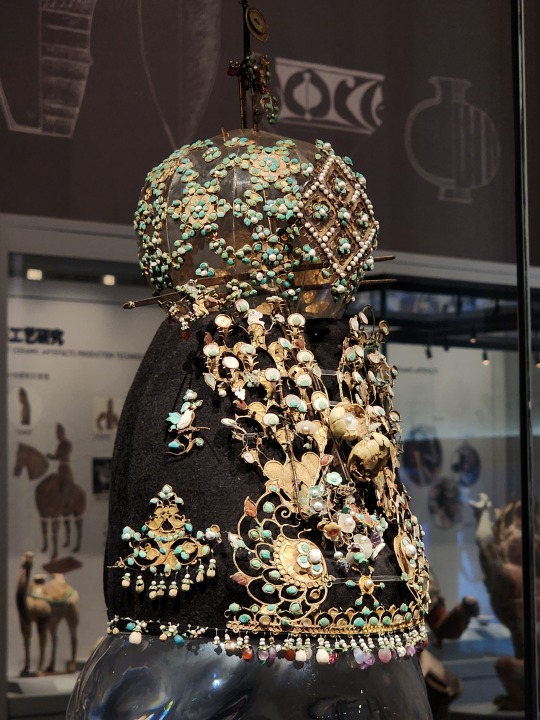
And it wasn't just a crown either. There were other pieces that were part of her outfit:
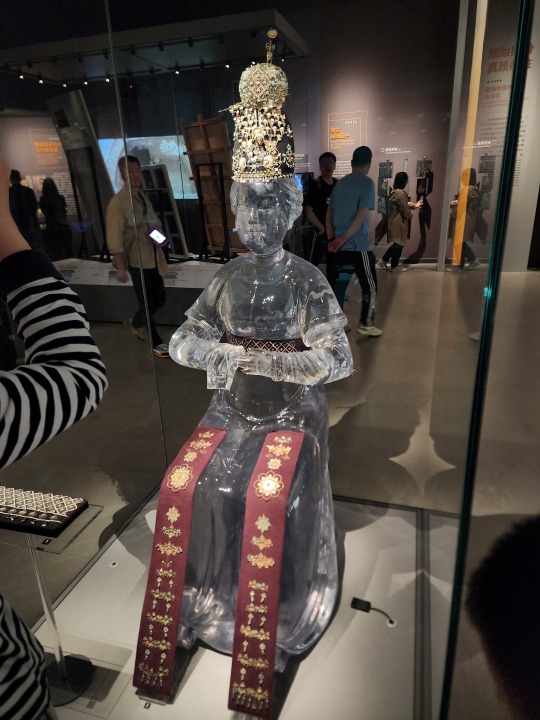
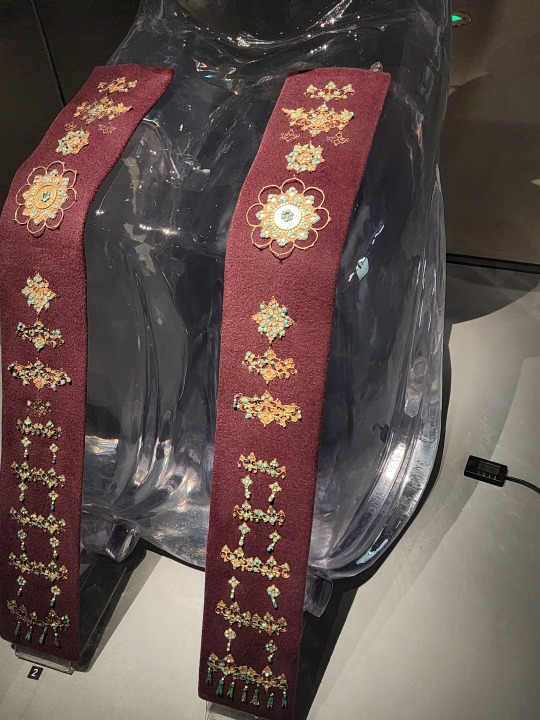

Various Tang-era gold and silver thread embroidery pieces found in the crypt of Famen Temple/法门寺, the plaque is visible in many of these so I won't be naming them all. There's a saying among Chinese archaeologists: "dry things last a thousand years, wet things last ten-thousand years, half-wet half-dry things last half a year" ("干千年,湿万年,不干不湿就半年"). This refers to the conditions the artifacts/remains were in over time, stable conditions usually preserve artifacts and remains better than changing conditions. Fabric-based artifacts are notoriously hard to preserve, especially in Xi'an's "half-wet half-dry" climate, so these are a rare sight:
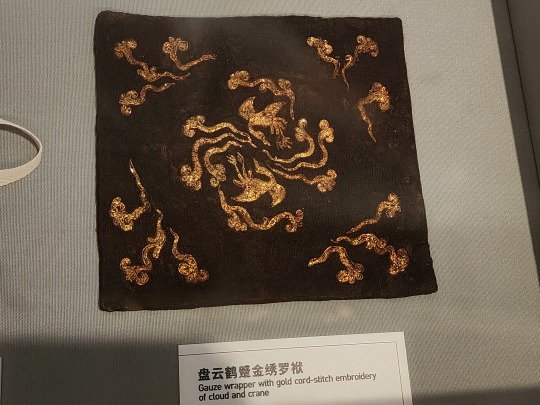
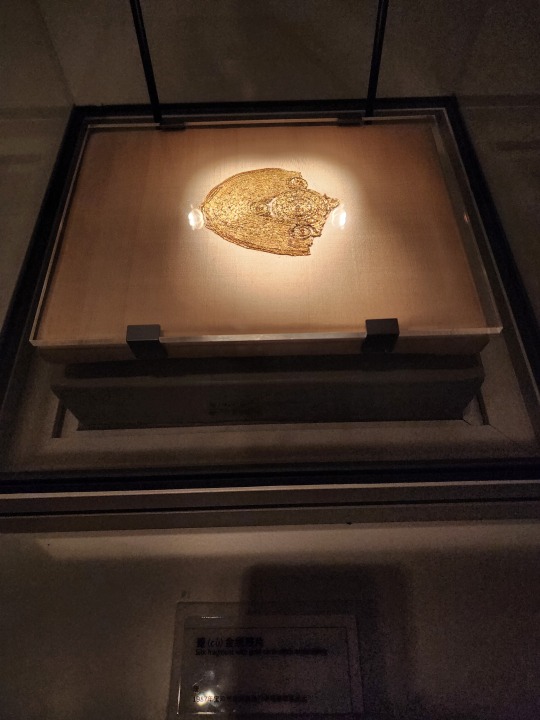
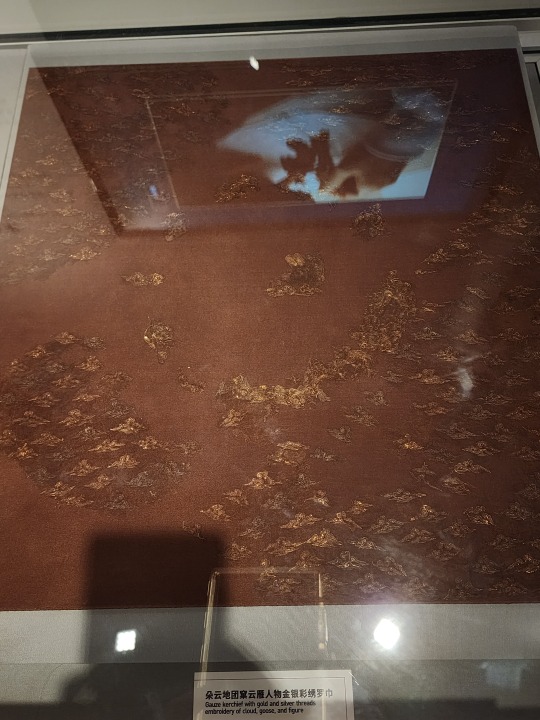
Note that the bird and flower design on the right is actually not an embroidery, but designs woven straight into the fabric:
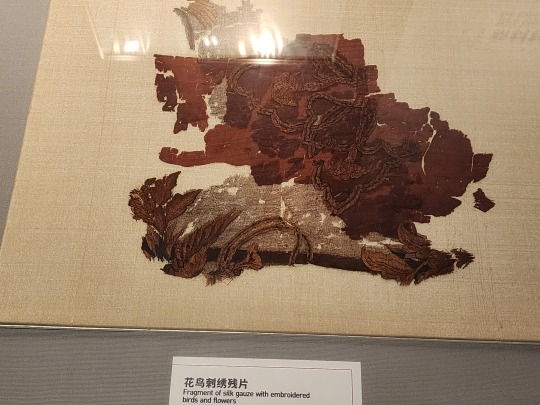
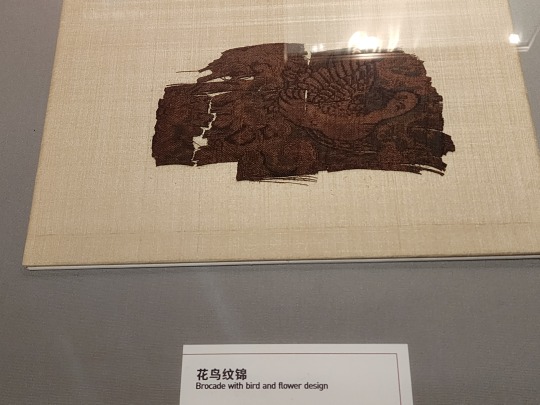
The gold threads used in these embroideries were made by wrapping long strips of gold foil around thread through the turning of these hook-shaped tools.
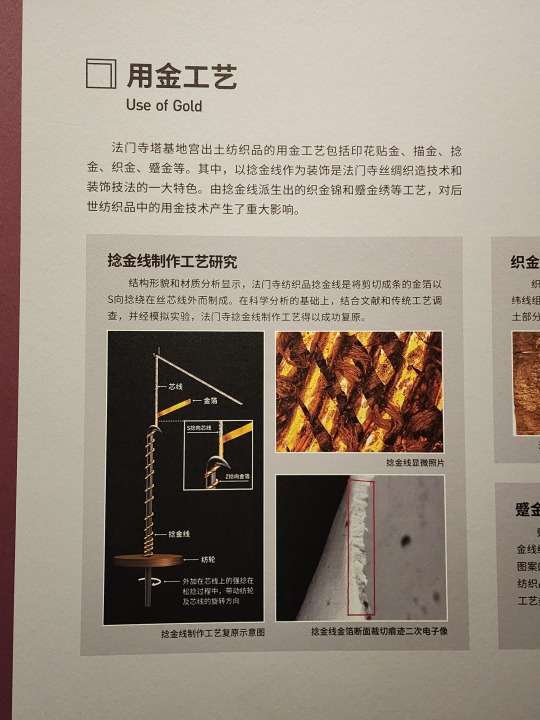
The gold threads produced from the above process were mainly used in two ways, either woven into the fabric (top), or embroidered onto fabric (bottom). The kind of embroidery here is called cujinxiu/蹙金绣, which uses gold threads and a technique that is similar to couching
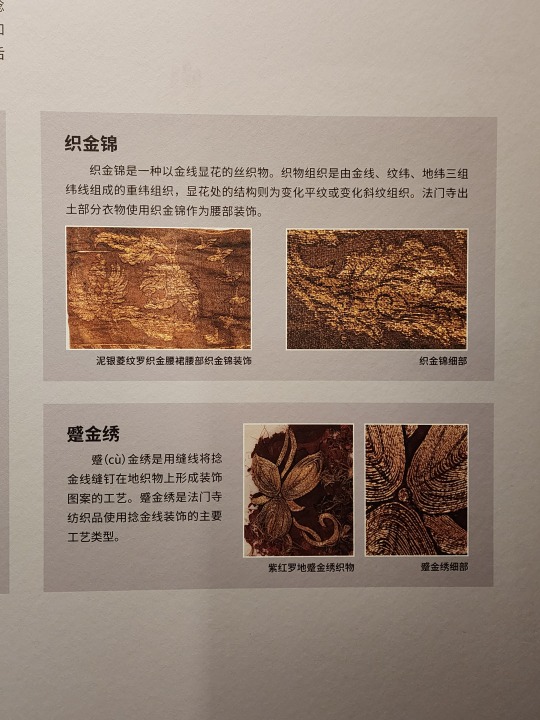
Models of the microscopic structure of different types of silk fabric found in Famen Temple. In common usage today, the term sha/纱 often refers to light, almost see-through polyester fabrics, but in the past this term refers exclusively to a type of light silk fabric. However, the other ones listed here (ling/绫, luo/罗, juan/绢, jin/锦) almost always refer to silk fabrics.
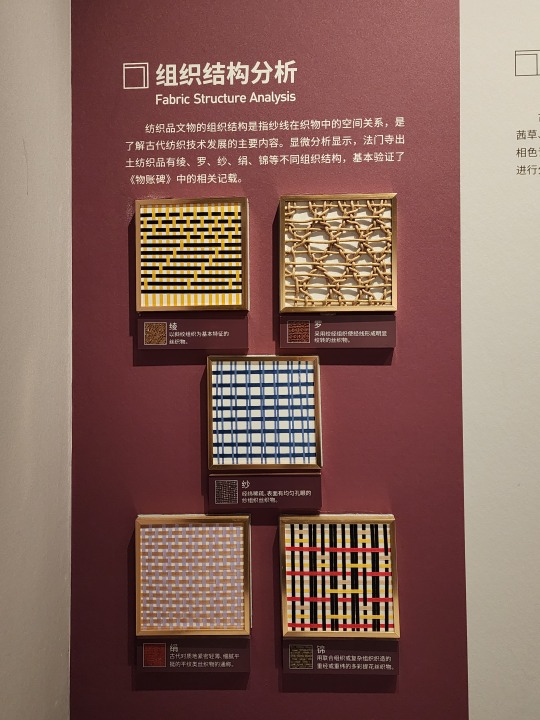
Different types of motifs/patterns found on artifacts throughout time. Left is the evolution of juancaowen/卷草纹 ("curled plant motif") from Tang dynasty to Jin dynasty (1115 - 1234). Right is the evolution of lianhuawen/莲���纹 ("lotus flower motif") from Northern Song dynasty (960 - 1127) to Yuan dynasty (1206 - 1368).
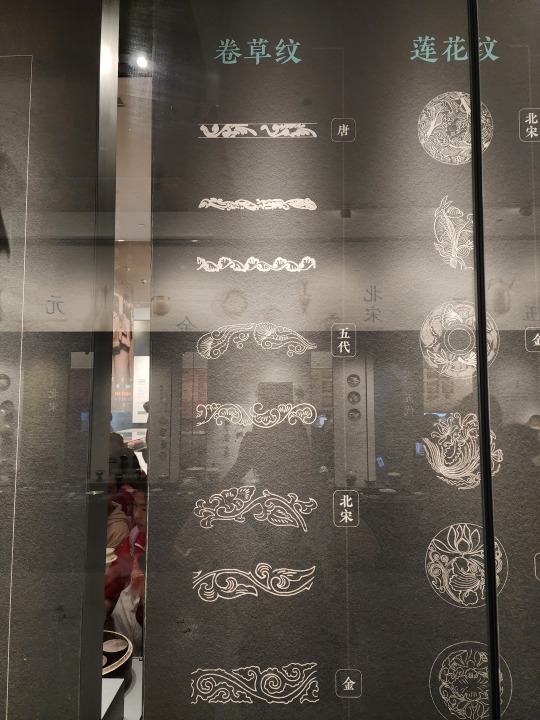
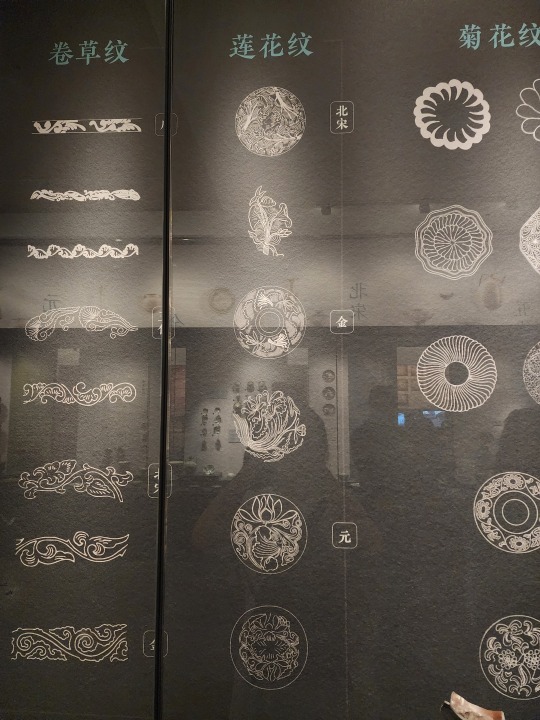
Left: evolution of juhuawen/菊花纹 ("chrysanthemum flower motif") from Tang dynasty to Yuan dynasty. Right: evolution of mudanwen/牡丹纹 ("moutan peony motif") from Tang dynasty to Yuan dynasty, and the evolution of youyuwen/游鱼纹 ("swimming fish motif") from Northern Song dynasty to Yuan dynasty.

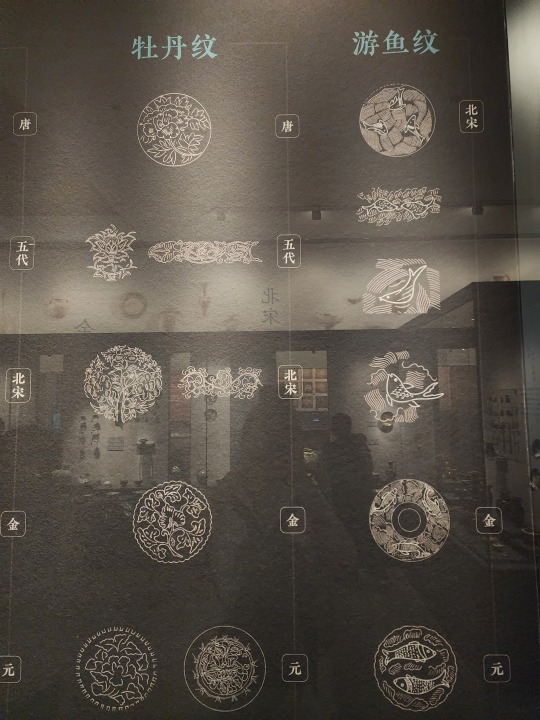
This is another one of my personal favorites, a Ming dynasty (1368 - 1644) bronze vessel with cloisonné enamel (called 掐丝珐琅 or jingtailan/景泰蓝 in Chinese). This type of vessel is called a gui/簋.
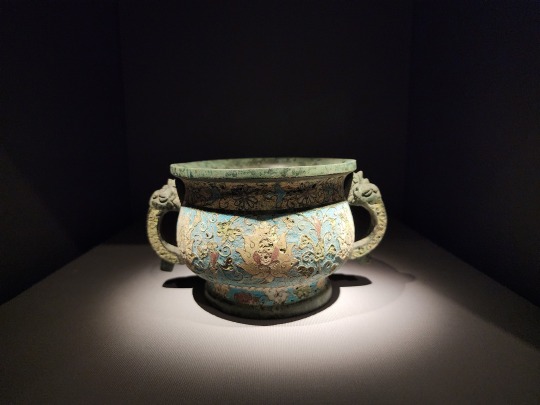
Song-era green-glazed porcelain from Yaozhou Kiln Site (耀州窑), so it's called yaoci/耀瓷 for short. This particular style is made by carving designs onto the piece before glazing and firing. I have attempted something similar when I took that wheelthrowing class years ago, but I failed lol
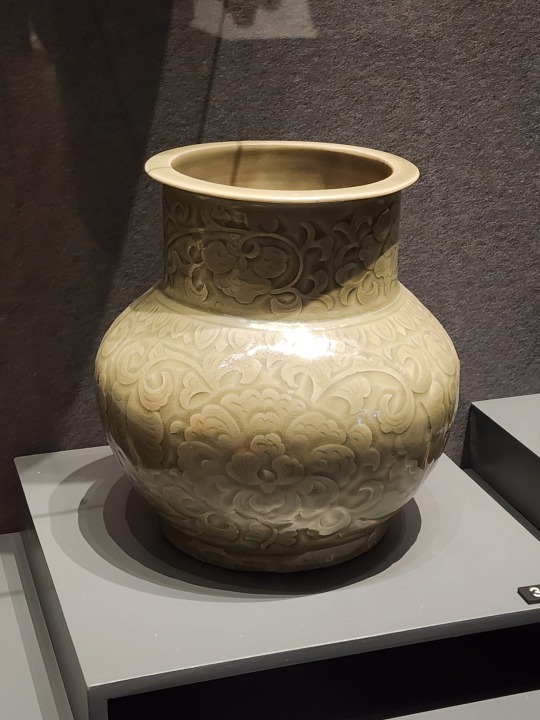
A Northern Song-era stone dui/敦 from the tomb of Lü Dalin/吕大临. The calligraphy here is in kaishu/楷书 script.

Also from the tomb of Lü Dalin, the left is a wine flagon with a dedicated holder used to warm the entire vessel along with the wine inside. The right is a incense burner with a swastika on top. Note that swastikas are very common in Chinese Buddhism, and is taken to mean "myriad" or "infinity" (the swastika is pronounced wan/萬, which literally means "ten-thousand", the figurative way of saying "infinity" in Chinese).
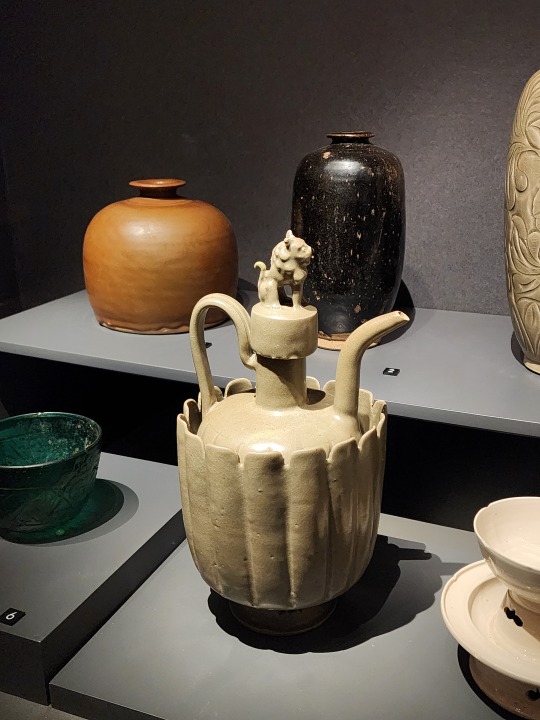
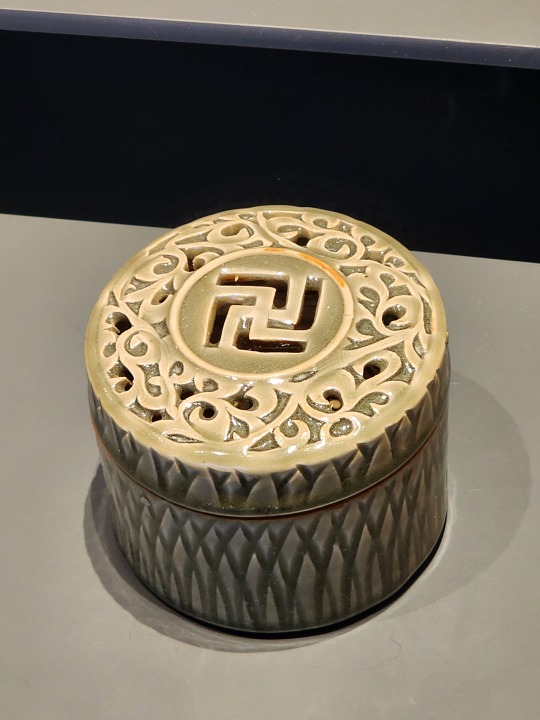
The process of making tea in Song dynasty, called diancha/点茶, which generally involves these steps: grinding the tea into a powder, sifting the tea powder, putting tea powder into a tea cup, pouring in hot water, and whisking the tea with a chaxian/茶筅 to create a light foam before drinking. In Song dynasty, the literati would hold contests among themselves to see who could make the perfect tea using the diancha method. This complex and time/effort consuming method was gradually phased out within China by the time of Ming dynasty, but deeply influenced Japanese tea making methods.
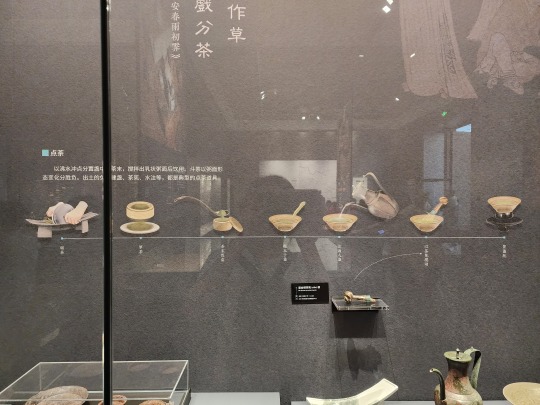
Left: a small porcelain piece depicting a mother lion and cub. The Chinese depiction of lions, called shi/狮, largely comes from a combination of the mythological suanni/狻猊, and the rare real lions that were given to China as gifts in the past. Right: a pottery dragon from Yuan dynasty, if I remembered correctly.

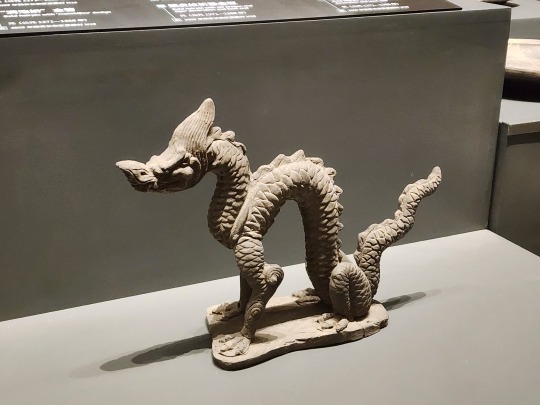
Also the previous part on Han dynasty (202 BC - 220 AD) artifacts was getting way too long, so I put these two pictures here at the end. In ancient China, many round coins had a square hole in the middle, and these holes were used to string the coins up for easier storage and counting. Such strings of coins are called minqian/缗钱, and this is why the quantifier for coins in ancient China is usually chuan/串, guan/贯, or diao/吊. In usage, chuan is not a strict quantifier, but 1 guan or diao = 1000 coins.
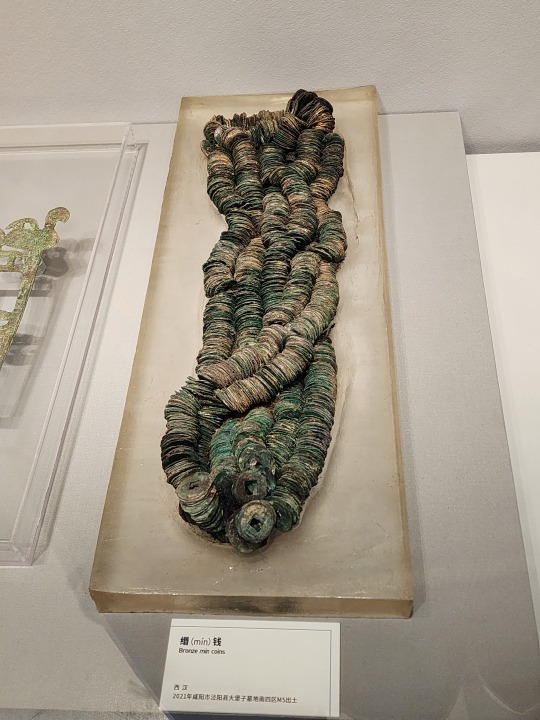
A modern recreation of a Han-era painted lacquer box, this red pattern on black background look is very characteristic of Han-era painted lacquerware:
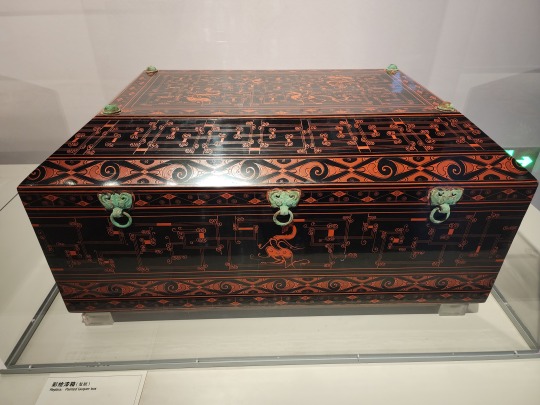
Painted pottery statue of a Buddhist deva:
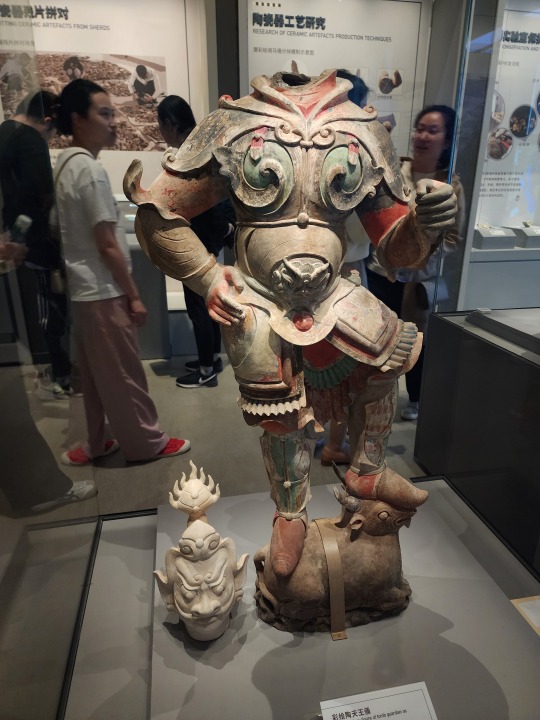
The painted wall murals of a Yuan dynasty tomb, viewed from below:
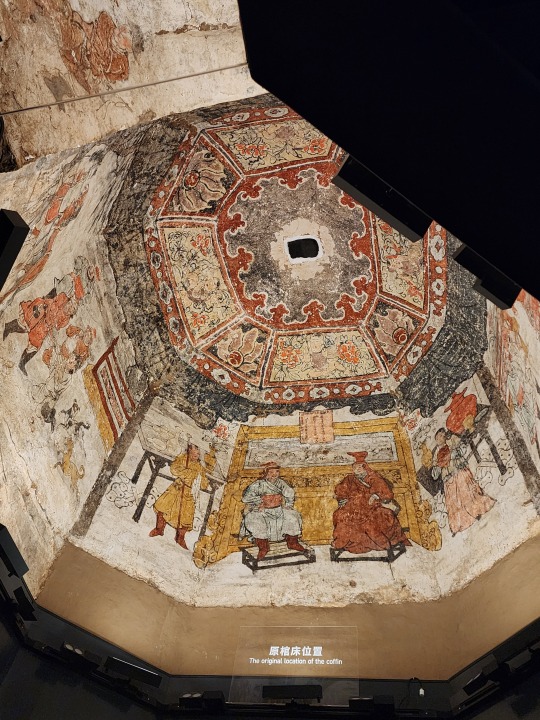
And this concludes the posts for Shaanxi Archaeology Museum! The next museum (also the last one) will be Shaanxi History Museum, specifically the new Qin-Han dynasties museum.
#2024 china#xi'an#china#shaanxi archaeology museum#chinese history#chinese culture#chinese hanfu#hanfu#chinese calligraphy#tang dynasty#song dynasty#jin dynasty#yuan dynasty#ming dynasty#embroidery#calligraphy#history#culture#archaeology
207 notes
·
View notes
Text
The main advantage with polyester over natural fibers is its durability as well as affordability
Aspects of Polyester Woven Fabric
Polyester, or perhaps polyethylene terephthalate, is just about the most popular synthetic fabric varieties. It is a resilient, inexpensive material that has found widespread easily use in everything from sports gear to industrial fabrics Polyester Woven Fabric Manufacturer plus household textiles. It is available in numerous types of textures, colors, and thicknesses, that will be printed with any design imaginable. This versatility helps it be an incredibly useful, practical material for many different applications and goods.
Woven polyester is a great choice for pillowcases since it's soft and comfortable yet firm enough to help withstand repeated use. Additionally it is very easy to clean and take care of and dries quickly following washing. Woven polyester is also perfect for blankets and various other home textiles because it's available in a variety of colors and can often be customized with any design you need.
The main advantage with polyester over natural fibers is its durability as well as affordability. It's more expensive than cotton but inexpensive than silk or constructed from wool, making it a great choice for items that has to be strong and long-lasting. Woven polyester is usually extremely versatile, and can be used in a wide range of garments and other textiles, through pants and shirts for you to skirts and dresses.
OEM Polyester Woven Fabric Whether you're looking to get a high-end designer dress or a couple sturdy work pants, there will probably be a woven polyester option that suits the needs you have. Woven polyester is also the end choice for outdoor apparel, like tents and tarps, since it's resistant to dampness and durable. It can be custom-printed for a different, personalized touch.
In addition to as being a popular fabric type in its own right, polyester is a vital ingredient of certain nonwoven fabrics. In fact, it's the key component of spun ribbons nonwoven fabrics, which are utilized in wet wipes as well as kitchen towels. It can also be used in medical plus hygiene products, such seeing that masks and hospital dresses.
While polyester can use a few negative impacts to the environment, it's an excellent material for a lot of different products and software. It's recyclable and is usually turned into new items or made into yarn-like thread for easily use in other fabrics. In truth, recycling polyester is a good way to reduce greenhouse energy emissions.
GD-001 100% Polyester Weft Knitting Polar Fleece

0 notes
Note
Punch-clock maid tf
Clock in and leave your old self and thoughts at the door, feel your outfit turn into a slutty maid’s as you become focused on cleaning everything
Clock out and leave feeling happier and lighter, anticipating the next shift
(Aka fuck capitalism lemme maid mode with no chronic pain)
*tick tick tick tick*
The incessant sound of the clock pendulum swinging as you enter the warm foyer, sheltered from the bitter cold outside, scratches at your mind in the most pleasant way. Somehow, in the past several months, the sound that once grated on your nerves now served to soothe and invite you in. After taking your coat off and hanging it next to the other coats on the wall, you crossed the room to grab your card, a thin slip of paper with dozens of stamped dates and times on it.
*tick tick tick tick*
Such a familiar sound, already causing your heartbeat fall in line. Your movements and footsteps seemed to align with the ticking of the clock as you approached it. Holding the punch card out, you slid it into place and...
*kchnk*
instantly your body shuddered as the stamp pressed into your card, marking a perfect start of your shift, on the hour, just as you did every day. All at once your body seized up, suddenly heavy and sluggish.
*tick tick tick tick*
The sound of the clock carried such a weight that seemed to hold you in place. Your joints felt heavy, your eyelids fluttering, and with every second your clothing weighed on you more. But even as that sensation grew, your clothing began to change. Your mass produced jeans and t-shirt rippling and shifting into light, soft ruffles and long billowing fabric. The soft caress of nylon up your legs soon hugged your hips as a ruffled, layered dress cascaded down around your upper thighs. The loose, baggy polyester of your shirt pulled inward, tightening and hardening into a corset that pushed your chest up and your waist in, a white, frilled apron flowing over it. Framing your chest to display your growing cleavage, the top of the dress materialized with poofy shoulders and miniscule straps, a small ribbon bow holding the two sides together across your chest with another wrapping gently around your neck to match.
*tick tick tick tick*
And as the physical transformation concluded, the soft and sexy maid outfit settling comfortably around your body, the familiar mental effects settled in. The ticking overwhelmed your thought, casting aside anything you had previously been thinking of and relieving any stress you had carried in with you. Soon, only thoughts of cleaning and serving the head of the household filled your mind, swirling in harmonious bliss alongside the firm guiding hand of the ticking clock. Gradually, your joints seemed to move, as though guided by the rigid ticks of the clock. Robotic movements that set you on the beginning of your day, making your way into the mansion and ascending the staircase to the master's office.
*tick tick tick tick*
Even with the clock out of earshot, its pendulum guided you up into place as you stood ready for your master's appraisal. As with every morning, she greeted you kindly as you entered her office, though your voice could only parrot the same response day in and day out. "Thank you, Master. I am at your service." She crossed the room to great you, hands reaching out to caress your soft body and send shivers down your spine.
"Now, my lovely maid. Why don't we wind you up for the day?"
Her question needed no response, as she produced a key from her pocket and gently pressed it against your back. The cold metal pressed against your skin and slowly you felt it rotate. Though the metal simply glided over your skin, it felt as though it ran much, much deeper. The inner mechanics of your body, woven by the ticking of the clock, whirred with excitement as the Master's key wound you up for the day. You could feel your movements become less mechanical, far more fluid and graceful. Your mind at ease as every task before you fell into place, your body and mind perfectly aligned to take on the day in service to the Master.
"There you are. All wound up and ready to clean, aren't you, my lovely maid?"
"Yes Master, I am ready to clean and serve."
"Very good. Then after you finish cleaning the downstairs and prepare lunch, why don't you come up and clean my bedroom for me. You've done so much to earn such a privilege."
Blushing and unable to hide your smile, you nodded. "As you wish, Master."
And the Master smiled, planting a kiss on your forehead, and ushered you off to begin your day.
32 notes
·
View notes
Note
Hii !! I love your work 🫶🫶 Your SFW alpahabet for Neil is absolutely adorable ! I wanted to know if you could write a Neil Perry x Black reader ? (Of course if you’re comfortable with that, since this time period is complicated 😭)
Love you !
And When At Last I Find You, Your Song Will Fill The Air - Neil Perry . ݁₊ ⊹ . ݁˖ . ݁
of course i would (*ᴗ͈ˬᴗ͈)ꕤ*.゚

Neil thought they were all stupid. How could they hate a girl like her? A girl so wonderful, bright — indescribable by even the finest sonnets or poets the world could begin to offer. She wasn't just some words in a piece of paper; all that life encompasses must be her, for how else could he explain the impending feeling in his belly? A hunger not for sustenance, but perhaps a different kind of it.
She resumed singing a melody she knew he loved, her voice echoing in the heart of the cave. Her nimble fingers stitched together an embroidered banner, small enough for him to hang in his room without his professors fussing over it. He loved her until the moon and back, and even then he'd still tug the crescent satellite down for her; perform his best act for it just so it could be persuaded to shine gently for her when she ought to sleep.
"How's that?" she halted her singing to hold the fabric up by her hands, biting off the thread before displaying it to his sight.
Neil hummed in approval, coming closer to inspect the fabric with his spectacles on. Her breaths fanned against his cheek, and it tinted them pink.
"It's red. I like it," he complimented. His brown eyes met hers, dainty and dark. Her bashful smile squeezed his heart and made it ache.
"Not just any red," she corrected, splaying the fabric on her lap for them to admire, "maroon, clementine, and amber."
She proudly showed him the nearly-finished design; a griffin flying above a stock of clouds and trees, above it the sun burned like a flame, woven with the finest polyester she found under her mother's bed. Neil knew it reminded her of him. And just on the griffin's neck laced a colorful wreath of lilies and dahlias, a reminder of her presence even when Welton tests him with the depths of its tribulations.
He pried the needle off her hand and reached his face up, ghosting just across the side of her nose. She hid her face, but he gave a silent plead by the pull of his fingers against hers.
"You're the most beautiful girl I've ever got to see," his eyes scanned her, every crevice of her beautiful skin and those lashes he loved so dearly. He grinned then, a boyish expression of affection. She relented, cupping his face and caressing it with her thumb.
"Someday soon, I'll take us far, far away from this place," he whispered against your palm, kissing it, "a farm, somewhere nice so we can have our children and let them play around in a place where no one could judge them. No one could judge us, peer at us — where you'll be mine, eternal.
"Would you want that?" he pleaded, searching for your answer.
Your tears were effervescent as they fell, Neil catching them before they wet your dress — your lovely, lovely dress which he bought for you last winter.
His heart leapt at the sight of you nodding,
"Yes," you laughed wetly, "yes, Neil, how could I ever say no to that?"
The two of you embraced in the nearing darkness of the cave, protected, safe. Loved by the soul of one another, guarded by the light of a candle much kinder than the sun which exposed them outside. Someday soon, he said,
then someday soon it will be.

Bet you didn't expect this ( ˘ ³˘)♥︎
#dead poets society#dps#dead poets headcanons#dead poets society fanfic#dead poets society movie#dead poets fandom#dead poets fanfic#dead poets aesthetic#neil perry#neil x reader#neil perry x you#neil perry x reader#neil perry fanfic#neil perry fanfiction#dps x reader#dead poets x reader#rsl#robert sean leonard#rsl x reader#robert sean leonard x reader
35 notes
·
View notes
Text
The Modern Elegance of Foil Print and Digital Print Velvet Fabrics at Sanchi Velvets
Velvet, with its timeless beauty and luxurious texture, has always been a fabric that exudes sophistication. But in recent years, advancements in printing techniques have brought new life to this classic fabric. Foil print velvet fabric and digital print velvet fabric are two exciting innovations that are revolutionizing the world of velvet design. At Sanchi Velvets, we offer an exquisite selection of these prints, combining the plush luxury of velvet with cutting-edge design aesthetics. Let's take a closer look at these two stunning velvet fabrics and how they can elevate your creations.
Foil Print Velvet Fabric: A Touch of Glamour and Shine
Foil print velvet fabric is a unique fusion of classic velvet's plush texture with a metallic foil print that adds an element of shimmer and shine. This fabric is perfect for adding drama and sophistication to any design. The foil print is often applied in intricate patterns or bold designs, creating a stunning contrast against the deep, rich hues of velvet.
Key Features of Foil Print Velvet Fabric
Eye-catching Shine: The metallic foil print reflects light beautifully, giving the fabric an added dimension and making it stand out in any setting.
Sophisticated Designs: Foil print velvet often features geometric patterns, floral motifs, or abstract designs, which can add an extra layer of elegance and modernity to the fabric.
Versatile Applications: From evening gowns to home decor accessories, foil print velvet is perfect for creating pieces that require a touch of glamour. It’s ideal for fashion-forward pieces like statement jackets, skirts, and accessories or for luxury upholstery, cushions, and curtains.
Textural Contrast: The soft, velvety feel of the fabric combined with the shiny foil print creates an interesting contrast, making it a luxurious and tactile fabric choice.
At Sanchi Velvets, you can explore a variety of foil print velvet fabrics in an array of colors, patterns, and finishes. Whether you're designing for the runway or for a sophisticated living room makeover, foil print velvet offers an exquisite combination of style and texture.
Digital Print Velvet Fabric: Bold Designs with Precision
Digital print velvet fabric is a modern take on traditional velvet, using digital printing technology to create intricate, detailed patterns directly onto the velvet. This technique allows for highly precise designs, including photorealistic images, vivid color gradients, and complex illustrations. Digital printing has made it easier to produce vibrant, customized velvet fabric with fine details that would be difficult to achieve with other printing methods.
Key Features of Digital Print Velvet Fabric
Intricate Designs: Digital printing allows for incredibly detailed and precise patterns, from floral and abstract designs to intricate landscapes and geometric shapes. This gives designers endless possibilities for creating unique, personalized fabric.
Vibrant Color: The digital printing process ensures that colors appear crisp and vibrant, giving the fabric a fresh, modern appeal.
Perfect for Statement Pieces: Digital print velvet is perfect for fashion designs that need bold, standout patterns. From high-fashion dresses to statement blazers and accessories, digital print velvet allows designers to push the boundaries of creativity.
High-Quality Finish: Despite the bold prints, digital print velvet maintains the luxurious texture and softness of traditional velvet, making it an ideal choice for both apparel and interior decor.
Sanchi Velvets’ digital print velvet fabrics are available in a stunning range of designs, from floral and paisley patterns to more contemporary, artistic graphics. The result is a beautiful combination of plush texture and bold design, perfect for those looking to make a statement.
Choosing Between Foil Print and Digital Print Velvet Fabrics
When deciding between foil print velvet fabric and digital print velvet fabric, the choice largely depends on the aesthetic you're aiming for and the purpose of your design.
Foil Print Velvet is ideal if you're seeking a fabric that combines the opulent texture of velvet with a shimmering, metallic effect. It’s perfect for high-fashion pieces, evening wear, or any design where you want to introduce a bit of glamour and shine. Additionally, the reflective nature of foil prints makes it great for home decor pieces where you want to add an element of light and sparkle.
Digital Print Velvet is best suited for those who want to incorporate intricate patterns, vivid colors, and detailed designs into their fabric. This option is perfect for designers who want to create standout, custom pieces or those looking to print complex, one-of-a-kind illustrations on velvet.
Conclusion: Discover the Future of Velvet at Sanchi Velvets
At Sanchi Velvets, we are proud to offer a wide range of premium velvet fabrics, including foil print velvet fabric and digital print velvet fabric. Each fabric brings its own unique set of benefits to the table—foil print velvet offers an alluring shine and sophistication, while digital print velvet pushes the boundaries of design with bold, intricate prints. No matter what your project requires, our velvet fabrics are sure to provide the luxurious texture and stunning visuals you need.
Explore the future of velvet at Sanchi Velvets today and bring your creative vision to life with our exclusive selection of foil print and digital print velvet fabrics. Whether you're designing for fashion or home decor, these fabrics will add a touch of modern elegance and innovation to your work.
To know more about Sanchi Velvets visit us on:
#Sunshine Velvets#Gold Line Velvet#Dispro Print Velvet Fabric#Disperse Print Velvet Fabric#Non Velvet Burnout Fabric#Cotton Slub Velvet#Velvet Manufacturers India#Cotton Viscose Velvet#Ice Velvet fabric#Viscose Rayon Velvet#Woven Velvet Fabric#Light Weight Velvet Fabric#Heavy Weight Velvet Fabric#Polyester Viscose Fabric#Foil Print Velvet Fabric#Digital Print Velvet Fabric#Polyester Velvet Fabric#Printed Velvet Fabric#Cotton Velvet Fabric#Polyester Satin Fabric#Floral Printed Velvet Fabric
0 notes
Note
Hello! I am newer to the sewing craft and hobby. I was wondering if you had any tips or thoughts on your favorite fabrics to use, qualities to look out for, and any other general tips you might want to give to a blooming designer. Most of my work is gonna be more whimsical and less historical, but that doesn't mean I can't use all the help and tips I can get going in! I will write down any valuable information you can give in my notes.
That is a VERY broad question and I don't really know how to answer without knowing more specifically what you're sewing! I do 18th century menswear, and very 18th century inspired everyday clothing, but I have no idea what you're looking to make, so I don't know if we need the same fabrics. Like, when I hear "more whimsical and less historical", for me that would be something like a tailored suit that looks like it's made of leaves, but for someone else it might be a big floofy ballgown.
But to answer the bit about my favourite fabrics - I prefer woven fabrics in natural fibres with no stretch. I use a lot of linen, cotton, wool, and some silk and rayon, with the weight and specific kind of fabric depending on what garment I'm making and what season it's for. Usually they're medium or heavy weight, with the exception of shirts. My favourite thing for nightgowns is thrifted 100% cotton bedsheets, my favourite thing for shirts is lightweight linen, and I like making pants out of heavy cotton and jackets and waistcoats out of wool suiting, but there are lots more materials I've used for these things.
And there are people who like to sew with stretch knits, or who use a lot of shiny synthetics, or lightweight gauzy fabrics! There are tons of different kinds of fabric, and the ones that are best for you will depend on what kind of garments you're making, what kind of wear they'll get, and your budget. (Though I will say that I'm a polyester & acrylic hater. Sometimes synthetics can be nice if you need something sparkly and shiny that can't be done with natural fibres, and I do usually machine sew with poly thread, but polyester fabrics are often a Bad Texture and they don't breathe and I avoid wearing or working with them.)
One thing that might be helpful is going to your nearest fabric store and touching lots of fabric and reading the labels. It's not the same as actually sewing with them, but it should help you get a bit more familiar with the textures of various weaves/how much they fray/etc. (Also looking at the fibre content on the labels of your own clothing, even though these days far too many things are polyester, or some sort of blend, and there are lots of great fabrics people are missing out on.)
I'd also recommend Nicole Rudolph's videos on fabric - she's got ones on wool, silk, linen, cotton, and tailoring supplies, which ought to give you a good idea of the various qualities of those particular natural fibres.
Here's a link to my FAQ, which has some other sewing questions I've answered over the years.
113 notes
·
View notes
Text
I hate buying things just to throw them out. We use rags and woven napkins etc.
I'm the past, I've wrapped gifts in flyers, butcher paper, and paper gift bags to minimize waste (or at least make it recyclable). This year I'm going a step further.
I bought some questionable fabric (listed as cotton, feels like polyester) and I'm making gift bags.

Basically just sewing the squares in half or together. Super simple, but with French seams for durability. Not bothering with my iron.
I'm undecided if I want to make pockets for drawstrings or tape them closed (some waste, but closer to typical unwrapping).
I'll probably still have to use paper for a few things but it's a step in the right direction. I'll try and pick up some bigger fabric pieces after Christmas when it's on sale.
26 notes
·
View notes